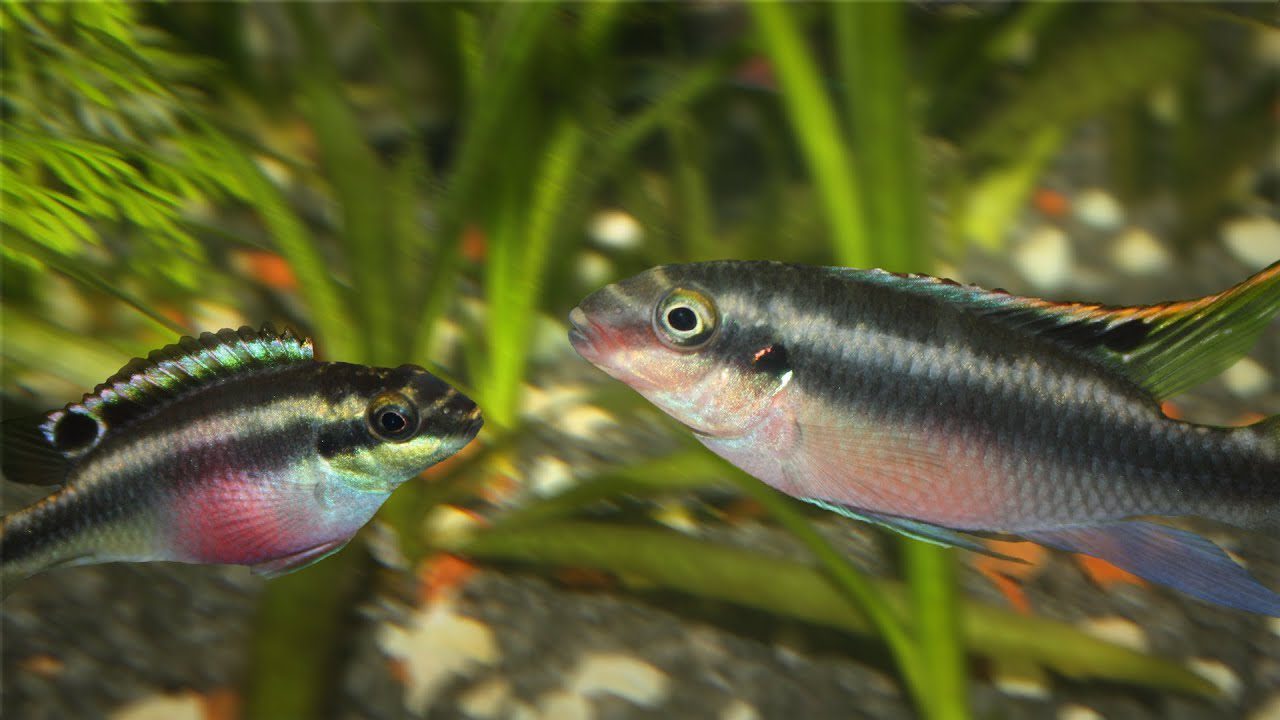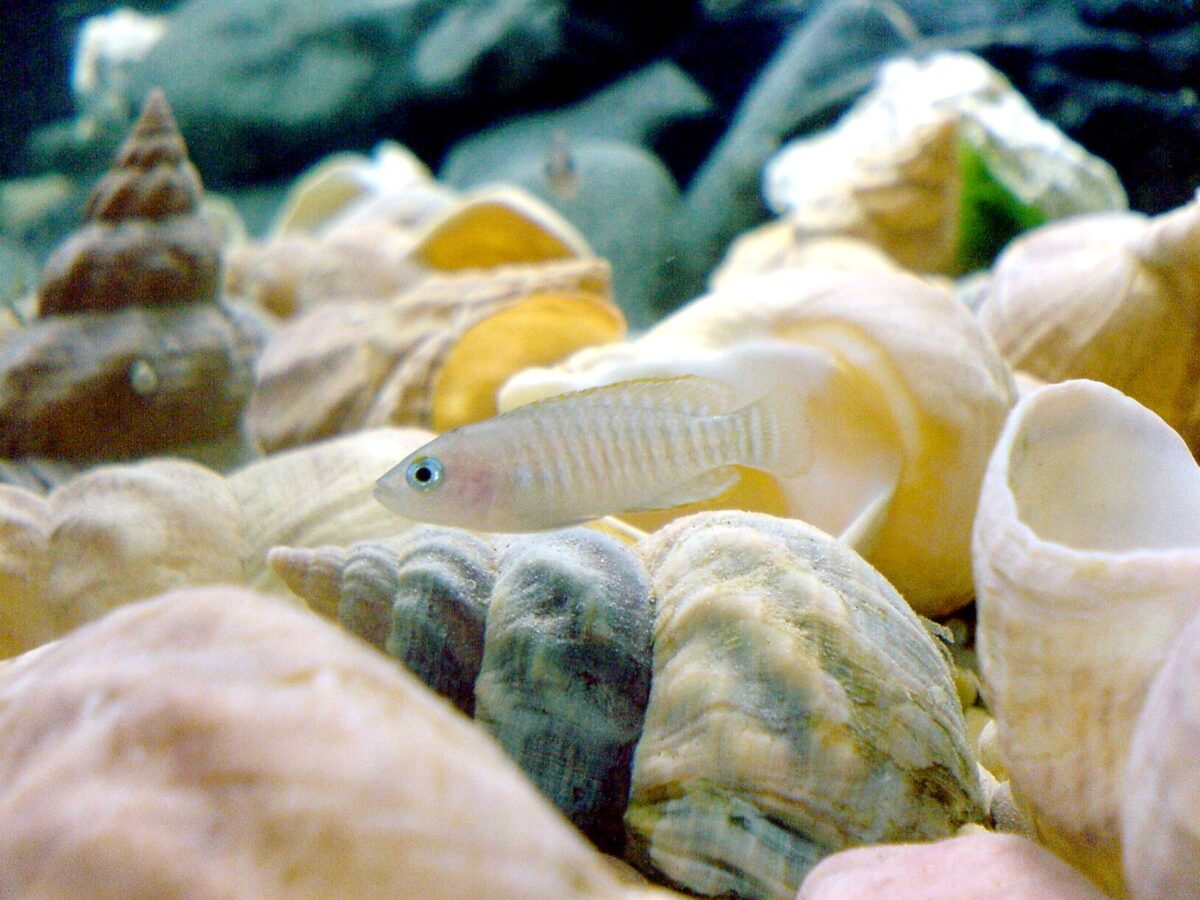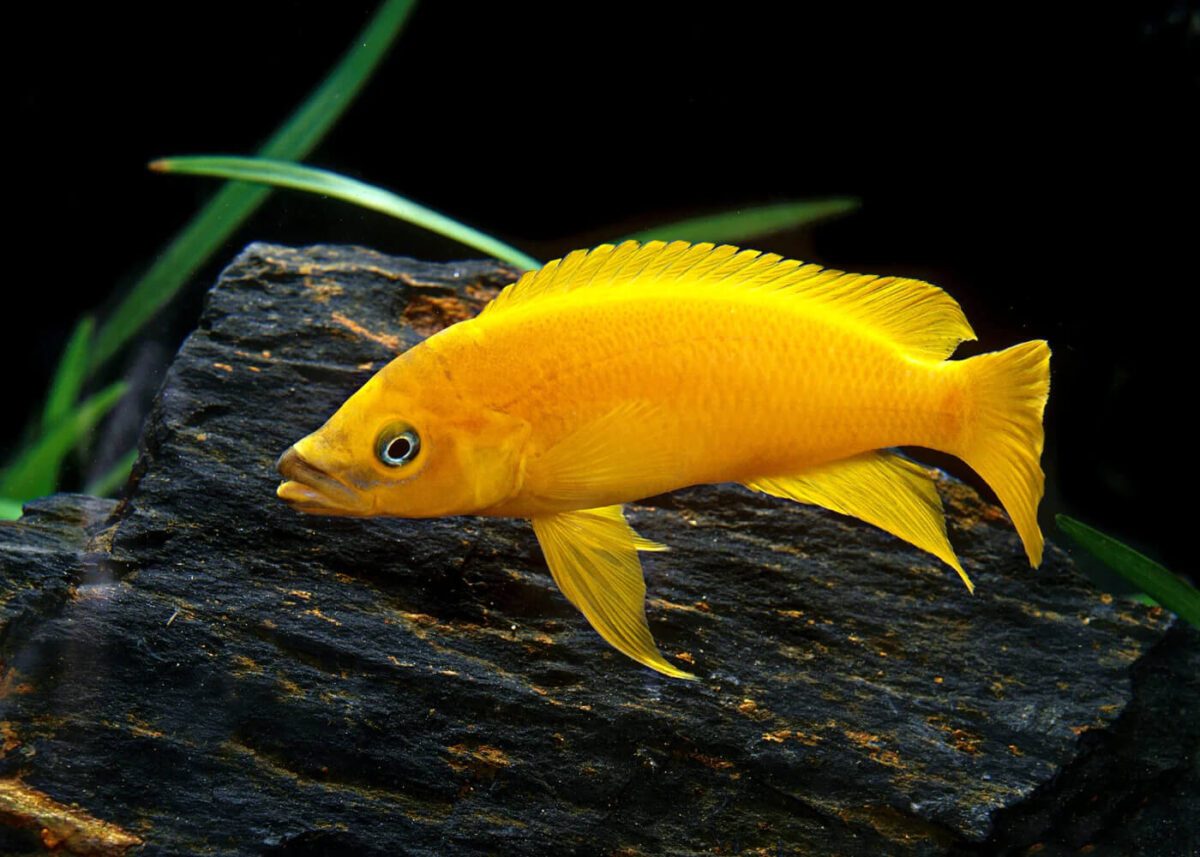Welcome to our guide on the (Pelvicachromis pulcher) Kribensis Cichlid, a fascinating African dwarf cichlid that has become increasingly popular in the aquarium hobby. If you’re looking for an eye-catching and vibrant addition to your freshwater tank, the Kribensis Cichlid might be the perfect choice.
In this comprehensive care guide, we will examine the Kribensis cichlid’s physical characteristics, behaviour, and breeding habits in depth. We will also provide valuable insights on setting up the ideal aquarium environment and offer tips for successfully caring for and breeding this delightful species.
Whether you are a beginner or an experienced aquarium enthusiast, this article will provide all the information you need to ensure the health and well-being of your Kribensis Cichlids. Let’s dive in!
Key Takeaways:
- The (Pelvicachromis pulcher) Kribensis Cichlid is a popular African dwarf cichlid known for its vibrant colours and interesting behaviour.
- Proper care and maintenance of the Kribensis Cichlid involve creating an ideal tank environment and providing a balanced diet.
- Breeding Kribensis Cichlids can be a rewarding experience, but it requires specific conditions and careful attention to detail.
- Kribensis Cichlids can coexist with various tank mates, but compatibility should be considered when selecting companions.
- Understanding the natural habitat and behaviour of Kribensis Cichlids is essential for creating a thriving aquarium environment.
Kribensis Cichlid – Introduction
Welcome to section 2 of our comprehensive guide to Kribensis Cichlids, one of the most popular freshwater fish in the aquarium hobby. In this section, we will delve into the taxonomy and classification of Kribensis Cichlids and their natural habitat and distribution. So, let’s dive in and explore the fascinating world of these beautiful and intriguing fish!
Taxonomy and Classification
The Kribensis Cichlid, scientifically known as Pelvicachromis pulcher, belongs to the family Cichlidae. Within the Cichlidae family, it falls under the subfamily Pseudocrenilabrinae and the genus Pelvicachromis. The species name “pulcher” refers to its striking beauty.
Natural Habitat and Distribution
The Kribensis Cichlid is native to the rivers and streams of West Africa, particularly Nigeria and Cameroon. It is commonly found in the Niger Delta region, including the Benue and Cross River basins, as well as Lake Barombi Mbo. These fish inhabit slow-moving waters with dense vegetation, such as swamps, marshes, and flooded areas.
Due to their popularity in the aquarium trade, Kribensis Cichlids have been introduced to various regions worldwide. They can now be found in several countries, including the United States, Europe, and Asia, where fishkeepers adore them for their vibrant colours and interesting behaviours.
Stay tuned for section 3, where we will explore the physical description, colours, and markings of Kribensis cichlids and their gender differences. Don’t miss out!
Physical Description and Characteristics
The Kribensis Cichlid, scientifically known as Pelvicachromis pulcher, is a visually striking freshwater fish that makes a captivating addition to any aquarium. As one of the most famous dwarf cichlids in the hobby, this species is well-known for its vibrant colours, unique markings, and distinct gender differences.
Colours and Markings
Kribensis Cichlids exhibit stunning colours and markings that add to their allure. Their bodies are primarily adorned with bold horizontal bands ranging from vibrant red, orange, and yellow to earthy browns and black. The intensity of these colours can vary among individuals, with some displaying more vivid hues than others. Their fins are adorned with intricate patterns and contrasting colours, enhancing their overall appearance.
Gender Differences
One of the most fascinating aspects of Kribensis Cichlids is the noticeable differences between males and females. Males typically showcase more vibrant and intense colours, extending their dorsal fins into elegant filaments. They also possess elongated ventral fins and develop a pronounced nuchal hump on their forehead during the breeding season. Meanwhile, females showcase more subdued colours and lack the elaborately extended fins and nuchal hump.
Varieties
The Kribensis Cichlid is available in various varieties, each with its distinct appearance. These include the “Super Red” variety, which displays a vibrant red colouration throughout its body, and the “Golden” variety, which exhibits a striking yellow hue. Other varieties may feature unique colour patterns or fin shape and size variations, providing enthusiasts a wide range of options.
Grades
Within each variety, Kribensis Cichlids can be graded based on the quality of their colours and markings. Higher-grade specimens showcase more intense and well-defined colours, while lower-grade individuals may exhibit less saturation or clarity. The grading system allows hobbyists to select specimens that best fit their preferences and desired aesthetic for their aquarium.
Behaviour and Temperament
Kribensis Cichlids are known for their intriguing behaviours and unique temperament. They are generally peaceful and can be kept in a community aquarium with other non-aggressive fish species. However, during the breeding season, they can become territorial and may exhibit aggressive behaviour towards other fish that venture near their nesting sites. It is recommended that multiple hiding places and sufficient territory be provided to mitigate any potential conflicts.
Aquarium Requirements
Creating an ideal environment for your Kribensis Cichlids is crucial for their health and well-being. By understanding the appropriate tank size and layout, water parameters, suitable tank mates, and compatibility with live plants and invertebrates, you can provide the best conditions for these beautiful fish.
Ideal Tank Size and Layout
A tank size of at least 20-30 gallons (75-113 litres) is recommended for Kribensis cichlids. A larger tank provides more swimming space and allows for better territorial distribution. Regarding layout, use rocks, caves, and driftwood to provide plenty of hiding spots. These features create territories for the fish and mimic their natural habitat, making them feel secure.
Water Parameters
Kribensis Cichlids thrive in conditions closely resembling their native African rivers and streams. Maintain a temperature range of 75-82°F (24-28°C), a slightly acidic to neutral pH of 6.0-7.5, and a moderate hardness level of 4-12 dH. Consistency in these water parameters is critical to keeping your Kribensis Cichlids healthy and stress-free.
Suitable Tank Mates and Potential Conflicts
When choosing tank mates for Kribensis Cichlids, it is crucial to consider their compatibility and potential conflicts. Peaceful community fish like tetras, rasboras, or Corydoras catfish can be suitable companions. However, avoid pairing them with aggressive or larger fish that may intimidate or harm the Kribensis Cichlids. Always research the temperament and behaviour of any potential tank mate before introducing them to the aquarium.
Compatibility with Live Plants and Invertebrates
Kribensis Cichlids are generally compatible with live plants and invertebrates but may uproot or eat certain plant species. Choosing hardy, fast-growing plants like Anubias, Java Fern, or Amazon Sword can withstand their digging or grazing behaviour. For invertebrates, consider small, peaceful species like snails or shrimp, which can coexist peacefully with the Kribensis Cichlids.
Kribensis Cichlid – Care
Proper care is essential for maintaining the health and well-being of Kribensis Cichlids in your aquarium. This section will provide a comprehensive guide on how to care for these beautiful fish, covering important aspects such as water quality, feeding, and maintenance.
Diseases
Like any living organism, Kribensis Cichlids are susceptible to various diseases. It is crucial to be aware of common diseases affecting these fish and take proactive measures to prevent and treat them. Understanding the symptoms and implementing proper care practices can help keep your Kribensis Cichlids healthy and thriving.
Some of the common diseases that Kribensis Cichlids may encounter include:
- Ich (Ichthyophthirius multifiliis): A parasitic disease characterized by developing white spots on the fish’s body and fins. It is highly contagious and can quickly spread throughout the aquarium.
- Fin Rot: This disease is often a secondary infection from poor water quality or physical injuries. It causes the degradation of the fish’s fins, leading to fraying and rotting.
- Mouth Fungus (Columnaris) is a bacterial infection characterized by white, cotton-like growth around the fish’s mouth and head. It can lead to loss of appetite, difficulty eating, and an overall decline in health.
Prevention is key when it comes to diseases in Kribensis Cichlids. Maintaining excellent water quality and providing a balanced diet are essential preventive measures. Regularly testing the water parameters, performing routine water changes, and ensuring a stress-free environment can significantly reduce the risk of diseases. Additionally, quarantining new fish before introducing them to the main aquarium can help prevent the spread of diseases.
If you notice any signs of illness in your Kribensis Cichlids, it is crucial to take immediate action. Quarantine the affected fish to prevent the disease from spreading to others, and consult with a veterinarian or experienced aquarist for proper diagnosis and treatment options. Medications formulated explicitly for treating fish diseases may be necessary in some cases.
By providing appropriate care and prompt attention to health issues, you can help your Kribensis Cichlids live long, healthy lives in your aquarium.
Diet and Feeding
Proper nutrition is essential for the health and well-being of Kribensis Cichlids. Understanding their dietary preferences and establishing a balanced feeding routine is crucial for their overall development and vitality.
Dietary Preferences
Kribensis Cichlids’ diet mainly consists of animal and plant matter. In their natural habitat, they feed on small invertebrates, worms, insects, and algae. To meet their nutritional needs, it is important to replicate these dietary preferences in the aquarium.
Recommended Foods and Feeding Schedule
Regarding feeding Kribensis Cichlids, various food options should be provided to promote a diverse diet. High-quality pellets and flakes formulated for cichlids serve as a staple food source. Additionally, offering live and frozen foods such as brine shrimp, bloodworms, and daphnia helps mimic their natural feeding habits.
It is recommended to feed Kribensis Cichlids in small amounts multiple times a day rather than one large feeding. This feeding schedule helps prevent overeating and maintains water quality in the aquarium. Observing their feeding behaviour and adjusting the portion size can ensure they receive adequate food without waste.
Tips on Ensuring a Balanced and Nutritious Diet
To ensure a balanced and nutritious diet for Kribensis Cichlids, consider the following tips:
- Include a mix of protein-rich and plant-based foods to provide a well-rounded diet.
- Supplement their diet with vitamin-rich foods to support their immune system and overall health.
- Avoid overfeeding, as it can lead to obesity and related health issues. Feed them an amount that they can consume within a few minutes.
- Monitor their appetite and adjust the feeding schedule accordingly. Reduce the frequency and quantity of food if they show signs of overeating or bloating.
- Assess their body condition regularly and adjust their diet if necessary. Healthy Kribensis Cichlids should have a well-rounded body shape without visible signs of emaciation or obesity.
Breeding and Reproduction
Breeding Kribensis Cichlids can be a rewarding experience for aquarium enthusiasts. This section provides a guide to successfully breeding and reproducing these fascinating fish. From sexing to caring for the eggs and fry, here’s everything you need to know to ensure a successful breeding process.
Sexing
Sexing Kribensis Cichlids is an essential step in the breeding process. Males and females have distinct physical characteristics that can help in identification. Males usually exhibit brighter colors, elongated dorsal fins, and a more pronounced red belly. Females, on the other hand, tend to have shorter dorsal fins and less vibrant colouration. By carefully observing these differences, you can determine the sex of your Kribensis Cichlids and create compatible pairs for breeding.
Breeding Behavior and Conditions
Kribensis Cichlids display fascinating breeding behaviours. During courtship, the male performs various displays and dances to attract the female. Once a bond is formed, the female chooses a suitable spawning site, typically a cave or crevice. Providing ample hiding spaces and caves in the breeding tank is crucial to creating a suitable environment for their reproductive behaviour.
The water conditions also play a vital role in inducing spawning. Kribensis Cichlids prefer slightly acidic to neutral water with a temperature range of 25-28°C (77-82°F). Maintain good water quality by performing regular water changes and ensuring the tank has appropriate filtration and aeration.
Care of Eggs and Fry
After spawning, the female Kribensis Cichlid will lay eggs on the chosen substrate and guard them. To prevent predation, it is essential to separate the parents from the eggs. You can transfer the eggs to a separate breeding tank or use a divider within the main tank to create a safe space for the eggs to develop.
The eggs typically hatch within 3-5 days, depending on the water temperature. At this stage, the fry will attach to the substrate and rely on their yolk sac for nourishment. As they grow, you can introduce commercially available fry food or crushed flakes to their diet. Maintain optimal water conditions and monitor the fry closely to ensure their healthy development.
Challenges in Breeding in Captivity
While breeding Kribensis Cichlids can be a rewarding experience, it is crucial to be aware of the challenges that may arise. Aggression between the breeding pair or towards other tank inhabitants can occur, especially during the spawning period. Providing ample hiding spaces and closely observing the behaviour of the fish can help mitigate potential conflicts.
Additionally, unfavourable water conditions, inadequate nutrition, or inexperienced breeding pairs can hinder successful reproduction. It is essential to research and understand the breeding requirements of Kribensis Cichlids thoroughly before attempting to breed them.
Summary
In summary, the (Pelvicachromis pulcher) Kribensis Cichlid is a popular freshwater fish for aquarium hobby. Throughout this article, we have covered various aspects of caring for and breeding Kribensis Cichlids. Here are the key points to remember:
Firstly, understanding the taxonomy, natural habitat, and distribution of Kribensis Cichlids is vital for providing them with a suitable environment.
Secondly, Kribensis Cichlids display various physical characteristics, including colours and markings. When selecting these fish for your aquarium, it is crucial to consider gender differences and the availability of multiple varieties and grades. Understanding their behaviour and temperament will help you choose appropriate tank mates.
Thirdly, providing the proper aquarium requirements, such as ideal tank size, suitable tank mates, and proper water parameters, is essential for the well-being of Kribensis Cichlids. Paying attention to their care needs, including preventing diseases and ensuring a balanced diet, will promote their overall health.
Lastly, if you are interested in breeding Kribensis Cichlids, learning how to sex them and creating suitable breeding conditions is crucial. Taking care of their eggs and fry requires specific attention, and being aware of potential challenges is essential.
We hope this comprehensive guide has provided valuable information and insights into the care and breeding of Kribensis Cichlids. You can confidently create a thriving and enjoyable aquarium environment for these fascinating fish with the knowledge gained.



